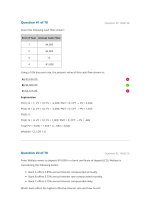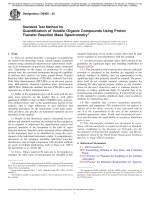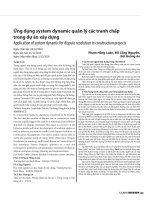feynman kac formula for switching diffusions connections of systems of partial differential equations and stochastic differential equations
Bạn đang xem bản rút gọn của tài liệu. Xem và tải ngay bản đầy đủ của tài liệu tại đây (277.94 KB, 13 trang )
Baran et al. Advances in Difference Equations 2013, 2013:315
/>
RESEARCH
Open Access
Feynman-Kac formula for switching
diffusions: connections of systems of partial
differential equations and stochastic
differential equations
Nicholas A Baran1 , George Yin1* and Chao Zhu2
*
Correspondence:
1
Department of Mathematics,
Wayne State University, Detroit, MI
48202, USA
Full list of author information is
available at the end of the article
Abstract
This work develops Feynman-Kac formulae for switching diffusion processes. It first
recalls the basic notion of a switching diffusion. Then the desired stochastic
representations are obtained for boundary value problems, initial boundary value
problems, and the initial value problems, respectively. Some examples are also
provided.
Keywords: switching diffusion; Feynman-Kac formula; Dirichlet problem; Cauchy
problem
1 Introduction
Because of the increasing demands and complexity in modeling, analysis, and computation, significant efforts have been made searching for better mathematical models in
recent years. It has been well recognized that many of the systems encountered in the
new era cannot be represented by the traditional ordinary differential equation and/or
stochastic differential equation models alone. The states of such systems have two components, namely, state = (continuous state, discrete event state). The discrete dynamics
may be used to depict a random environment or other stochastic factors that cannot be
represented in the traditional differential equation models. Dynamic systems mentioned
above are often referred to as hybrid systems. One of the representatives in the class of hybrid system is a switching diffusion process. A switching diffusion process can be thought
of as a number of diffusion processes coupled by a random switching process. At a first
glance, these processes are seemingly similar to the well-known diffusion processes. A
closer scrutiny shows that switching diffusions have very different behavior compared to
traditional diffusion processes. Within the class of switching diffusion processes, when
the discrete event process or the switching process depends on the continuous state, the
problem becomes much more difficult; see [, ]. Because of their importance, switching diffusions have drawn much attention in recent years. Many results such as smooth
dependence of the initial data, recurrence, positive recurrence, ergodicity, stability, and
numerical methods for solution of stochastic differential equations with switching, etc.,
have been obtained. Nevertheless, certain important concepts are yet fully investigated.
The Feynman-Kac formula is one of such representatives.
©2013 Baran et al.; licensee Springer. This is an Open Access article distributed under the terms of the Creative Commons Attribution License ( which permits unrestricted use, distribution, and reproduction in any
medium, provided the original work is properly cited.
Baran et al. Advances in Difference Equations 2013, 2013:315
/>
Page 2 of 13
For diffusion processes, the Feynman-Kac formula provides a stochastic representation
for solutions to certain second-order partial differential equations (PDEs). These representations are standard in any introductory text to stochastic differential equations (SDEs);
see, for example, [–], and references therein. The utility of Feynman-Kac formula has
enjoyed a wide-range of applications in such areas as stochastic control, mathematical
finance, risk analysis, and related fields.
This work aims to derive Feynman-Kac formula for switching diffusions. It provides a
probabilistic approach to the study of weakly coupled elliptic systems of partial differential equations (see [] for weakly coupled systems). Such systems arise in financial mathematics and in the form of the so called diffusion-reaction equations, which describe the
concentration of a substance under the influence of diffusion and chemical reactions. The
case where the discrete process is a two state process can be found in [, Section .]. Our
effort is on developing general results, in which the switching process has a finite state
space and is continuous-state dependent.
The rest of the paper is organized as follows. We begin by presenting the necessary background materials and problem formulation regarding switching diffusions in Section .
The setup is in line with that of []. Then, using the generalized Itô formula and Dynkin’s
formula, we present the Feynman-Kac formula in the context of the Dirichlet problem in
Section , the initial boundary value problem in Section . Finally, we study the Cauchy
problem in Section .
2 Switching diffusions
Let ( , F , P) be a probability space, and let {Ft } be a filtration on this space satisfying
the usual condition (i.e., F contains all the null sets and the filtration {Ft } is right continuous). The probability space ( , F , P) together with the filtration {Ft } is denoted by
( , F , {Ft }, P). Suppose that α(·) is a stochastic process with right-continuous sample
paths (or a pure jump process), finite-state space M = {, . . . , m }, and x-dependent generator Q(x), so that for a suitable function f (·, ·),
Q(x)f (x, ·)(i) =
qij (x) f (x, j) – f (x, i)
for each i ∈ M.
()
j∈M,j=i
Assume throughout the paper that Q(x) satisfies the q-property []. That is, Q(x) = (qij (x))
satisfies
(i) qij (x) is Borel measurable and uniformly bounded for all i, j ∈ M and x ∈ Rn ;
(ii) qij (x) ≥ for all x ∈ Rn and j = i; and
(iii) qii (x) = – j=i qij (x) for all x ∈ Rn and i ∈ M.
Let w(·) be an Rn -valued standard Brownian motion defined on ( , F , {Ft }, P), b(·, ·) :
Rn × M → Rn , and σ (·, ·) : Rn × M → Rn × Rn such that the two-component process
(X(·), α(·)) satisfies
dX(t) = b X(t), α(t) dt + σ X(t), α(t) dw(t),
()
X(), α() = (x, i)
and
P α(t + δ) = j|α(t) = i, X(s), α(s), s ≤ t = qij X(t) δ + o(δ),
i = j.
()
Baran et al. Advances in Difference Equations 2013, 2013:315
/>
Page 3 of 13
The process given by () and () is called a switching diffusion or a regime-switching diffusion. Now, before carrying out our analysis, we state a theorem regarding existence and
uniqueness of the solution of the aforementioned stochastic differential equation, which
will be important in what follows.
Theorem (Yin and Zhu []) Let x ∈ Rn , M = {, . . . , m }, and Q(x) = (qij (x)) be an
m × m matrix satisfying the q-property. Consider the two component process Y (t) =
(X(t), α(t)) given by () with initial data (x, i). Suppose that Q(·) : Rn → Rm ×m is bounded
and continuous, and that the functions b(·, ·) and σ (·, ·) satisfy
b(x, i) + σ (x, i) ≤ K + |x| ,
i ∈ M,
()
for some constant K > , and for each N > , there exists a positive constant MN such that
for all i ∈ M and all x, y ∈ Rn with |x| ∨ |y| ≤ MN ,
b(x, i) – b(y, i) ∨ σ (x, i) – σ (y, i) ≤ MN |x – y|,
()
where a ∨ b = max(a, b) for a, b ∈ R. Then there exists a unique solution to (), in which the
evolution of the discrete component is given by ().
Note that () and () are known as the linear growth and local Lipschitz conditions, respectively. We assume these conditions on b(·, ·) and σ (·, ·) for the remainder of the paper.
2.1 Itô’s Formula
Consider (X(t), α(t)) given in (), and let a(x, i) = σ (x, i)σ (x, i), where σ (x, i) denotes the
transpose of σ (x, i). Given any function g(·, i) ∈ C (Rn ) with i ∈ M, define L by
Lg(x, i) := tr a(x, i)D g(x, i) + b (x, i)Dg(x, i) + Q(x)g(x, ·)(i),
()
∂g
∂g
where Dg(·, i) = ( ∂x
, . . . , ∂x
), D g(·, i) denotes the Hessian of g(·, i), and Q(x)g(x, ·)(i) is
n
given by (). The choice for L will become clear momentarily.
It turns out that the evolution of the discrete component can be represented as a
stochastic integral with respect to a Poisson random measure p(dt, dz), whose intensity
is dt × m(dz), where m(·) is the Lebesgue measure on R. We have
dα(t) =
R
h X(t), α(t–), z p(dt, dz),
()
where h is an integer-valued function; furthermore, this representation is equivalent to
(). For details, we refer the reader to [] and [].
We now state (generalized) Itô’s formula. For each i ∈ M and g(·, i) ∈ C (Rn ), we have
g X(t), α(t) – g X(), α()
t
=
Lg X(s), α(s) ds + M (t) + M (t),
()
Baran et al. Advances in Difference Equations 2013, 2013:315
/>
Page 4 of 13
where
t
M (t) =
Dg X(s), α(s) , σ X(s), α(s) dw(s),
t
M (t) =
R
g X(s), α() + h X(s), α(s), z
– g X(s), α(s) μ(ds, dz).
The compensated or centered Poisson measure μ(ds, dz) = p(ds, dz) – ds × m(dz) is a martingale measure. For t ≥ , and g(·, i) ∈ C (the collection of C functions with compact
support) for each i ∈ M,
t
Ex,i g X(t), α(t) – g(x, i) = E x,i
Lg X(s), α(s) ds,
()
where Ex,i denotes the expectation with initial data (X(), α()) = (x, i). The above equation
is known as Dynkin’s formula. The condition g ∈ C ensures that
t
g X(t), α(t) – g(x, i) –
Lg X(s), α(s) ds is a martingale.
Furthermore, one can show that L agrees with its classical interpretation, as the (infinitesimal) generator of the process (X(t), α(t)) given by
Lg(x, i) = lim
t↓
Ex,i [g(X(t), α(t))] – g(x, i)
.
t
()
To see this, pick t sufficiently small so that α(t) agrees with the initial data. Then it follows
that
t
t
Lg X(s), α(s) ds
=
t
t
Lg X(s), i ds → Lg(x, i),
t→
by continuity. Hence by multiplying by t – , then letting t tend to zero, one gets
E
t
t
Lg X(s), α(s) ds – Lg(x, i) → ,
as t → ,
and, consequently, (). Noting (), when the deterministic time t is replaced by a stopping
time τ satisfying τ < ∞ w.p. (recalling that g(·, i) ∈ C ), then
τ
Ex,i g X(τ ), α(τ ) – g(x, i) = E x,i
Lg X(s), α(s) ds.
()
Note that if τ is the first exit time of the process from a bounded domain satisfying τ < ∞
w.p., then Dynkin’s formula holds for any g(·, i) ∈ C and each i ∈ M without the compact
support assumption. To proceed, we obtain the following system of Kolmogorov backward
equations for switching diffusions; see also [].
Baran et al. Advances in Difference Equations 2013, 2013:315
/>
Page 5 of 13
Theorem (Kolmogorov backward equation) Suppose that g(·, i) ∈ C (Rn ), for i ∈ M,
and define
u(x, t, i) = Ex,i g X(t), α(t) .
()
Then u satisfies
⎧
⎨ ∂u = Lu
for t > , x ∈ Rn , i ∈ M,
∂t
⎩u(x, , i) = g(x, i) for x ∈ Rn , i ∈ M.
()
A proof of the theorem can be found in [, Theorem .]; see also Theorem . in the
aforementioned reference.
Remark We illustrate the proof of the theorem using the idea as in [, p. ]. Fix t > .
Then using () and the Markov property, we have
Ex,i [u(X(r), t, α(r))] – u(x, t, i)
r
=
Ex,i [EX(r),α(r) [g(X(t), α(t))]] – Ex,i [g(X(t), α(t))]
r
=
Ex,i [Ex,i [g(X(t + r), α(t + r))|Fr ] – Ex,i [g(X(t), α(t))]
r
Ex,i [g(X(t + r), α(t + r))] – Ex,i [g(X(t), α(t))]
r
∂u
u(x, t + r, i) – u(x, t, i)
→
(x, t, i) as r ↓ .
=
r
∂t
=
Thus, by the definition of L, () is satisfied.
3 The Feynman-Kac formula
We now state the Feynman-Kac formula, which is a generalization of the Kolmogorov
backward equation.
Theorem (The Feynman-Kac formula) Suppose that g(·, i) ∈ C (Rn ), and let c(·, i) ∈
C(Rn ) be bounded; i ∈ M. Define
t
v(x, t, i) = Ex,i exp –
c X(s), α(s) ds g X(t), α(t) .
()
Then v satisfies
⎧
⎨ ∂v = Lv – cv
for t > , x ∈ Rn , i ∈ M,
∂t
⎩v(x, , i) = g(x, i) for x ∈ Rn , i ∈ M.
Proof To simplify the notation, let
t
Y (t) = g X(t), α(t) ,
Z(t) = exp –
c X(s), α(s) ds .
()
Baran et al. Advances in Difference Equations 2013, 2013:315
/>
Page 6 of 13
Now, following the argument in Remark , we fix t > . We have
Ex,i [v(X(r), t, α(r))] – v(x, t, i)
r
=
=
=
=
=
Ex,i [EX(r),α(r) [Z(t)Y (t)]] – Ex,i [Z(t)Y (t)]
r
Ex,i [Ex,i [exp (–
t
Ex,i [Ex,i [exp (–
t+r
r
c(X(s + r), α(s + r)) ds)Y (t + r)|Fr ]] – Ex,i [Z(t)Y (t)]
r
Ex,i [Z(t + r) exp (
r
c(X(s), α(s)) ds)Y (t + r)|Fr ]] – Ex,i [Z(t)Y (t)]
r
c(X(s), α(s)) ds)Y (t + r)] – Ex,i [Z(t)Y (t)]
r
Ex,i [Z(t + r)Y (t + r)] – Ex,i [Z(t)Y (t)]
r
Ex,i [Z(t + r)Y (t + r){exp (
r
v(x, t + r, i) – v(x, t, i)
=
r
r
c(X(s), α(s)) ds) – }]
Ex,i [Z(t + r)Y (t + r){exp (
r
r
c(X(s), α(s)) ds) – }]
+
+
.
First, clearly,
∂v
v(x, t + r, i) – v(x, t, i)
→ (x, t, i),
r
∂t
r ↓ .
Furthermore, we claim that
Ex,i [Z(t + r)Y (t + r){exp (
r
r
c(X(s), α(s)) ds) – }]
→ c(x, i)v(x, t, i).
To verify this claim, first, note that
Z(t + r)Y (t + r) → Z(t)Y (t),
r ↓ ,
by continuity. Now, if we let
r
c X(s), α(s) ds ,
f (r) = exp
for r sufficiently small. Denote the first jump time of α(·) by τ . With α() = i, for any
t ∈ [, τ ), α(t) = i. It follows that
r
c X(s), i ds ,
f (r) = exp
r ∈ [, τ ).
Hence f is differentiable at the origin and
d
f () = f ()c X(), i = c(x, i).
dt
Baran et al. Advances in Difference Equations 2013, 2013:315
/>
Page 7 of 13
This in turn yields that
Z(t + r)Y (t + r) ·
exp
r
= Z(t + r)Y (t + r)
r
c X(s), α(s) ds –
f (r) – f ()
r
→ Z(t)Y (t)c(x, i),
r ↓ .
Furthermore, the assumptions on the functions c(·, i) and g(·, i) ensure that this forms a
bounded sequence, so we may apply the bounded convergence theorem to yield
lim Ex,i Z(t + r)Y (t + r)
r↓
exp
r
= Ex,i lim Z(t + r)Y (t + r)
r↓
r
c X(s), α(s) ds –
exp
r
r
c X(s), α(s) ds –
= Ex,i Z(t)Y (t)c(x, i) = c(x, i)Ex,i Z(t)Y (t) = c(x, i)v(x, t, i)
as claimed. This completes the proof.
So we have seen that the functions given by () and () necessarily satisfy certain initial value problems. The remainder of the paper will be dedicated to giving stochastic
representations for solutions to certain partial differential equations (PDEs) related to the
operator L.
4 The Dirichlet problem
Let O ⊂ Rn , be a bounded open set, and consider the following Dirichlet problem:
⎧
⎨Lu(x, i) + c(x, i)u(x, i) = ψ(x, i) in O × M,
⎩u(x, i) = ϕ(x, i)
on ∂O × M,
()
where ∂O denotes the boundary of O. To proceed, we impose assumption (A).
(A) The following conditions hold:
. ∂O ∈ C ,
. for some ≤ j ≤ r, and all i ∈ M, minx∈O¯ ajj (x, i) > ,
¯ for each i ∈ M,
. a(·, i) and b(·, i) are uniformly Lipschitz continuous in O
¯ for each i ∈ M,
. c(x, i) ≤ and c(·, i) is uniformly Hölder continuous in O
¯
. ψ(·, i) is uniformly continuous in O, and ϕ(·, i) is continuous on ∂O, both for
each i ∈ M.
It follows that under (A), the system of boundary value problems has a unique solution;
see [] or []. Our goal is to derive a stochastic representation for this problem, similar to
the Feynman-Kac formula. In order to achieve this, we need the following lemma.
Lemma Suppose that τ = inf{t ≥ : X x (t) ∈/ O}. That is, τ is the first exit time from the
open set O of the switching diffusion given in () and (). Then τ < ∞ w.p..
Proof We use the idea as in []. Consider a function V : Rn × M → R defined by
V (x, i) = –A exp(λx ),
A, λ > , i ∈ M.
Baran et al. Advances in Difference Equations 2013, 2013:315
/>
Page 8 of 13
Clearly V (·, i) ∈ C ∞ (O) and since V is independent of i ∈ M,
Q(x)V (x, ·)(i) =
qij (x) V (x, j) – V (x, i) = ,
i=j
and, thus,
LV (x, i) = –A exp (λx )
a λ + b λ .
–b
Note that as long as λ > a
, it follows that LV (x, i) < . Hence, by choosing λ and A = A(λ)
sufficiently large, we can make LV (x, i) ≤ – for each i ∈ M. As the function V (·, i) and
¯ we may apply Dynkin’s formula to yield
its derivatives w.r.t. x are bounded on O,
t∧τ
Ex,i V X(t ∧ τ ), α(t ∧ τ ) – V (x, i) = Ex,i
LV X(s), α(s) ds
≤ –Ex,i (t ∧ τ ),
where Ex,i denotes the expectation taken with (X(), α()) = (x, i). This yields that
Ex,i (t ∧ τ ) ≤ V (x, i) – Ex,i V X(t ∧ τ ), α(t ∧ τ ) ≤ max V (x, i) < ∞.
¯ M
x∈O,i∈
Taking the limit as t → ∞, and using the monotone convergence theorem yields Ex,i τ < ∞,
which in turn leads to τ < ∞ w.p..
Theorem Suppose that (A) holds. Then with τ as in the previous lemma, the solution
of the system of boundary value problems () is given by
τ
u(x, i) = Ex,i ϕ X(τ ), α(τ ) exp
c X(s), α(s) ds
t
τ
– Ex,i
c X(s), α(s) ds dt .
ψ X(t), α(t) exp
Proof We apply Itô’s formula to the switching process
t
u˜ X(t), t, α(t) := u X(t), α(t) exp
c X(s), α(s) ds .
To simplify notation, we let
t
Z(t) = exp
c X(s), α(s) ds .
We have
Ex,i u X(t ∧ τ ), α(t ∧ τ ) Z(t ∧ τ ) – u(x, i)
t∧τ
= Ex,i
∂
+L
∂s
u X(s), α(s) Z(s) ds
()
Baran et al. Advances in Difference Equations 2013, 2013:315
/>
t∧τ
= Ex,i
Page 9 of 13
Z(s) u X(s), α(s) c X(s), α(s) + Lu X(s), α(s)
ds
t∧τ
= Ex,i
Z(s)ψ X(s), α(s) ds.
Taking the limit as t → ∞ and noting the boundary conditions, () follows.
5 The initial boundary value problem
Consider next the initial boundary value problem given by
⎧
∂
⎪
⎪
⎨[L + ∂t ]u(x, t, i) + c(x, t, i)u(x, t, i) = ψ(x, t, i) in O × [, T) × M,
u(x, T, i) = ϕ(x, i)
in O × M,
⎪
⎪
⎩
u(x, t, i) = φ(x, t, i)
on ∂O × [, T] × M,
()
where O is the same as before and
Lf (x, t, i) = tr a(x, t, i)D f (x, t, i) + b (x, t, i)Df (x, t, i) + Q(x)f (x, t, ·)(i).
()
We will use assumption (A).
(A) The following conditions hold:
. a(x, t, i)y, y ≥ κ|y| , for each i ∈ M and for y ∈ Rn (κ > ),
¯ × [, T], for each
. alk (·, ·, i), bl (·, ·, i) are uniformly Lipschitz continuous in O
i ∈ M,
¯ × [, T], for each
. c(·, ·, i) and ψ(·, ·, i) are uniformly Hölder continuous in O
i ∈ M,
¯ φ(·, ·, i) is continuous on ∂O × [, T], for each i ∈ M,
. ϕ(·, i) is continuous on O,
where ∂O denotes the boundary of O,
. ϕ(x, i) = φ(x, T, i), for x ∈ ∂O.
Under (A), it follows that the system of initial boundary value problems has a unique
solution; see [] or []. In order to get a stochastic representation for the solution, we
also require the drift and diffusion coefficients of u to be Lipschitz continuous in the time
variable; namely we require
b(x, t, i) – b(x, s, i) ∨ σ (x, t, i) – σ (x, s, i) ≤ K |t – s| ,
i ∈ M,
in addition to () and ().
Now, for (x, t, i) ∈ O × [, T) × M, consider the switching SDE given by
dX(s) = b X(s), s, α(s) ds + σ X(s), s, α(s) dw(s),
s ∈ [t, T],
()
with initial data (X(t), α(t)) = (x, i). If we let σ (x, t, i) be the square root of a(x, t, i), then the
following is true.
Baran et al. Advances in Difference Equations 2013, 2013:315
/>
Page 10 of 13
Theorem Suppose that (A) holds. Then the solution of the system of initial value problems in () is given by
τ
u(x, t, i) = Ex,i I{τ
c X(r), r, α(r) dr
t
T
+ Ex,i I{τ =T} ϕ X(T), α(T) exp
c X(r), r, α(r) dr
t
τ ∧T
– Ex,i
s
c X(r), r, α(r) dr ds .
ψ X(s), s, α(s) exp
t
()
t
Proof Proceeding similarly to the previous theorem, we apply Itô’s formula to the process
s
c X(r), r, α(r) dr ,
u X(s), s, α(s) exp
s ∈ [t, T].
t
To simplify notation, we let
s
Zt (s) = exp
c X(r), r, α(r) dr .
t
We have
Ex,i u X(τ ∧ T), τ ∧ T, α(τ ∧ T) Zt (τ ∧ T) – u(x, t, i)
τ ∧T
= Ex,i
t
τ ∧T
= Ex,i
∂
+L
∂s
u X(s), s, α(s) Zt (s) ds
Zt (s) u X(s), s, α(s) c X(s), s, α(s) + Lu X(s), s, α(s)
ds
t
τ ∧T
= Ex,i
Zt (s)ψ X(s), s, α(s) ds.
t
If we note that
⎧
⎨u(X(τ ), τ , α(τ ))Z (τ ),
τ < T,
t
u X(τ ∧ T), τ ∧ T, α(τ ∧ T) Zt (τ ∧ T) =
⎩u(X(T), T, α(T))Zt (T), τ = T
⎧
⎨φ(X(τ ), τ , α(τ ))Z (τ ), τ < T,
t
=
⎩ϕ(X(T), α(T))Zt (T), τ = T,
then by replacing the correct value for
u X(τ ∧ T), τ ∧ T, α(τ ∧ T) Zt (τ ∧ T)
in the above derivation, one gets ().
Baran et al. Advances in Difference Equations 2013, 2013:315
/>
Page 11 of 13
6 The Cauchy problem
If we let O = Rn in the initial value problem () of the previous section, we get the Cauchy
problem
⎧
⎨[L +
in Rn × [, T) × M,
∂
]u(x, t, i) + c(x, t, i)u(x, t, i) = ψ(x, t, i)
∂t
⎩u(x, T, i) = ϕ(x, i)
in Rn × M.
()
To proceed, we impose assumption (A).
(A) The following conditions hold:
. The functions alk (·, ·, i), bl (·, ·, i) are bounded in Rn × [, T] and uniformly
Lipschitz continuous in (x, t, i) in compact subsets of Rn × [, T] × M, for each
i ∈ M.
. The functions alk (·, ·, i) are Hölder continuous in x, uniformly with respect to
(x, t, i) in Rn × [, T] × M, for each i ∈ M.
. The function c(·, ·, i) is bounded in Rn × [, T] and uniformly Hölder
continuous in (x, t, i) in compact subsets of Rn × [, T] × M, for each i ∈ M.
. The function ψ(·, ·, i) is continuous in Rn × [, T], for each i ∈ M, Hölder
continuous in x with respect to (x, t, i) ∈ Rn × [, T] × M, and
in Rn × [, T] × M.
ψ(x, t, i) ≤ K + |x|p ,
. The function ϕ(·, i) is continuous in Rn , for each i ∈ M, and
|ϕ(x, i)| ≤ K( + |x|p ), where K and p are positive constants.
Under (A), it follows that the Cauchy problem has a unique solution; see [] or [].
Moreover, the following is true.
Theorem Suppose that (A) holds. Then the solution of the Cauchy problem in () is
given by
T
u(x, t, i) = Ex,i ϕ X(T), α(T) exp
c X(s), s, α(s) ds
t
T
– Ex,i
s
c X(r), r, α(r) dr ds .
ψ X(s), s, α(s) exp
t
()
t
Proof As before, by Itô’s formula, one has
Ex,i u X(T), T, α(T) Zt (T) – u(x, t, i)
T
= Ex,i
t
∂
+L
∂s
u X(s), s, α(s) Zt (s) ds.
Now, proceeding as in the proof of the initial boundary value problem, we get ().
Remark Note by taking c = ψ = , we see that the Kolmogorov backward equation is a
special case of the Cauchy problem by replacing u by
˜ t, i) := u(x, T – t, i).
u(x,
Baran et al. Advances in Difference Equations 2013, 2013:315
/>
Page 12 of 13
6.1 Examples
This section presents a couple of examples.
Example Let O ⊂ Rn be an open set, and consider the following weakly coupled system:
⎧
⎪
⎪
⎨ u(x, ) + q (x)u(x, ) + q (x)u(x, ) = ψ(x, ) in O,
u(x, ) + q (x)u(x, ) + q (x)u(x, ) = ψ(x, ) in O,
⎪
⎪
⎩
u(x, ) = u(x, ) =
on ∂O.
()
q (x) q (x)
Where Q(x) = q
satisfies the q-property. Such systems are studied in []. It
(x) q (x)
follows that this Dirichlet problem has the unique solution
τ
u(x, i) = –Ex,i
ψ x + B(t), α(t) dt ,
where B(t) is a standard, n-dimensional Browning motion, and α(t) is a two-state, discrete
process with generator Q(x).
Example
Let
Li = tr a(x, i)D g(x, i) + b (x, i)Dg(x, i);
i = , ,
and consider the following stationary system; found in [].
⎧
⎪
⎪
⎨L u(x, ) + q (x)u(x, ) + q (x)u(x, ) = in O,
L u(x, ) + q (x)u(x, ) + q (x)u(x, ) = in O,
⎪
⎪
⎩
u(x, i) = ϕ(x, i)
on ∂O.
It follows that the solution of the above problem has the form:
τ
u(x, i) = Ex,i ϕ X(τ ), α(τ ) exp
q˜ X(s), α(s) ds ,
where q˜ (x, i) = qii (x) + qij (x) and α(t) is a two-state process satisfying:
P α(t + δ) = j|α(t) = i, X(s), α(s), s ≤ t = qij X(t) δ + o(δ).
q (x) q (x)
satisfies the q-property, then it follows that
Hence if the generator Q(x) = q
(x) q (x)
q˜ (x, i) = for all x, so the solution reduces to the form:
u(x, i) = Ex,i ϕ X(τ ), α(τ ) ,
which agrees with the solution to the Dirichlet problem given by:
⎧
⎨Lu(x, i) =
in O × {, },
⎩u(x, i) = ϕ(x, i) on ∂O × {, }.
Baran et al. Advances in Difference Equations 2013, 2013:315
/>
Remark In closing, we make the following remark. Recall that a vector γ = (γ , . . . , γn )
with nonnegative integer components is referred to as a multi-index. Put |γ | = γ + · · · + γn ,
γ
and define Dx as
Dγx =
γ
∂x
∂ |γ |
γ .
· · · ∂xnn
Let us state another condition.
(A) For each i ∈ M, b(·, i) and σ (·, i) have continuous partial derivatives with respect
to the variable x up to the second order and that
Dγx b(x, i) + Dβx σ (x, i) ≤ K + |x|β ,
where K and β are positive constants and γ is a multi-index with |γ | ≤ .
In Theorems and , we used the approach in [] to derive the desired equations. If we
assume that (A) holds, then the functions defined by the stochastic representations ()
and () are smooth and classical solutions to the systems of parabolic equations () and
(), respectively; see [] for further details.
Competing interests
There are no competing interests.
Authors’ contributions
All authors contributed to the formulation, analysis, and proofs of theorems; all of them read and approved the final
manuscript.
Author details
1
Department of Mathematics, Wayne State University, Detroit, MI 48202, USA. 2 Department of Mathematical Sciences,
University of Wisconsin-Milwaukee, Milwaukee, WI 53201, USA.
Acknowledgements
The research of N. Baran and G. Yin was supported in part by the Army Research Office under grant W911NF-12-1-0223.
The research of C. Zhu was supported in part by the National Science Foundation under DMS-1108782, and a grant from
the UWM Research Growth Initiative.
Received: 15 July 2013 Accepted: 20 September 2013 Published: 08 Nov 2013
References
1. Yin, G, Zhu, C: Hybrid Switching Diffusions: Properties and Applications. Springer, New York (2010)
2. Yin, G, Zhu, C: Properties of solutions of stochastic differential equations with continuous-state-dependent switching.
J. Differ. Equ. 249, 2409-2439 (2010)
3. Friedman, A: Stochastic Differential Equations and Applications. Dover, New York (2006)
4. Khasminskii, RZ: Stochastic Stability of Differential Equations, 2nd edn. Springer, Berlin (2012)
5. Mao, X: Stochastic Differential Equations and Their Applications. Horwood, Chichester (1997)
6. Øksendal, B: Stochastic Differential Equations: An Introduction with Applications. Springer, Berlin (2010)
7. Mitidieri, E, Sweers, G: Weakly coupled elliptic systems and positivity. Math. Nachr. 173(1), 259-286 (1995)
8. Freidlin, M: Functional Integration and Partial Differential Equations. Annals of Mathematics Studies, vol. 109.
Princeton University Press, Princeton (1985)
9. Skorokhod, A: Asymptotic Methods in the Theory of Stochastic Differential Equations. Amer Mathematical Society,
vol. 78 (2008)
10. Weinberger, HF: Some remarks on invariant sets for systems. In: Maximum Principles and Eigenvalue Problems in
Partial Differential Equations. Pitman Research Notes in Math, vol. 173, pp. 189-207 (1988)
10.1186/1687-1847-2013-315
Cite this article as: Baran et al.: Feynman-Kac formula for switching diffusions: connections of systems of partial
differential equations and stochastic differential equations. Advances in Difference Equations 2013, 2013:315
Page 13 of 13








